Analysis of IBM's Knowledge Management System, Models, and Processes
VerifiedAdded on 2021/06/17
|12
|2716
|54
Report
AI Summary
This report provides a comprehensive analysis of IBM's Knowledge Management System (KMS). It begins with an introduction to IBM, its global operations, and the importance of KMS for its service business. The report then reviews relevant literature on knowledge management, highlighting the significance of KM models and processes in IT projects and organizational performance. A detailed review of IBM's KMS follows, focusing on key components like Knowledge Management Systems, Knowledge Management Technologies, and Knowledge Management processes. The report delves into various KM processes, including knowledge discovery, capture, sharing, and application, and discusses how IBM utilizes tools like the ICM tool and ShareNet. The analysis also examines IBM's use of the WIIG model, which is a framework to assess the completeness, connectedness, congruency, perspective, and purpose of knowledge. The report concludes by emphasizing the importance of knowledge management for IBM's success and its commitment to continuous improvement in this area, and the effective use of knowledge management strategies.
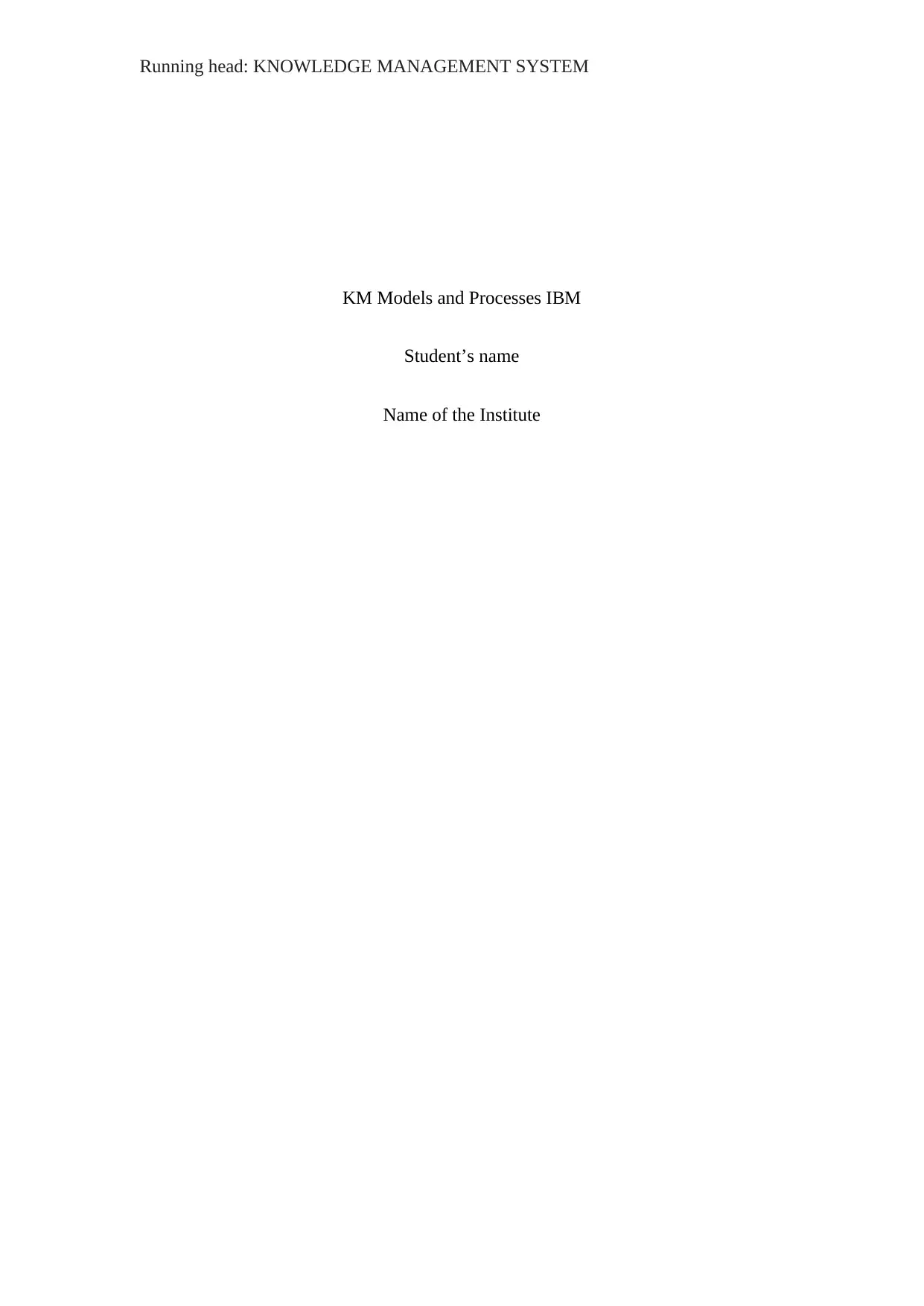
Running head: KNOWLEDGE MANAGEMENT SYSTEM
KM Models and Processes IBM
Student’s name
Name of the Institute
KM Models and Processes IBM
Student’s name
Name of the Institute
Paraphrase This Document
Need a fresh take? Get an instant paraphrase of this document with our AI Paraphraser
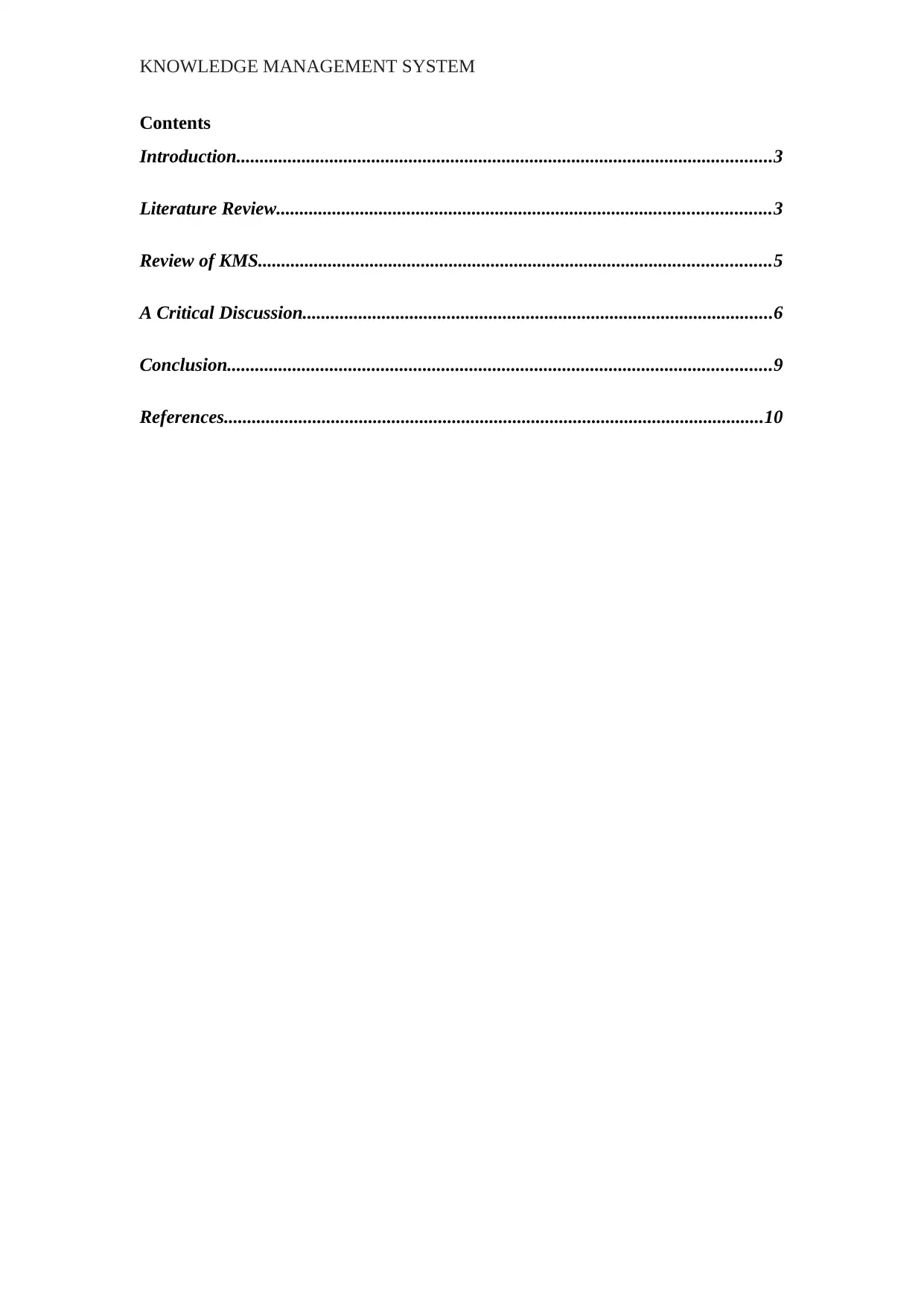
KNOWLEDGE MANAGEMENT SYSTEM
Contents
Introduction...................................................................................................................3
Literature Review..........................................................................................................3
Review of KMS..............................................................................................................5
A Critical Discussion.....................................................................................................6
Conclusion.....................................................................................................................9
References....................................................................................................................10
Contents
Introduction...................................................................................................................3
Literature Review..........................................................................................................3
Review of KMS..............................................................................................................5
A Critical Discussion.....................................................................................................6
Conclusion.....................................................................................................................9
References....................................................................................................................10
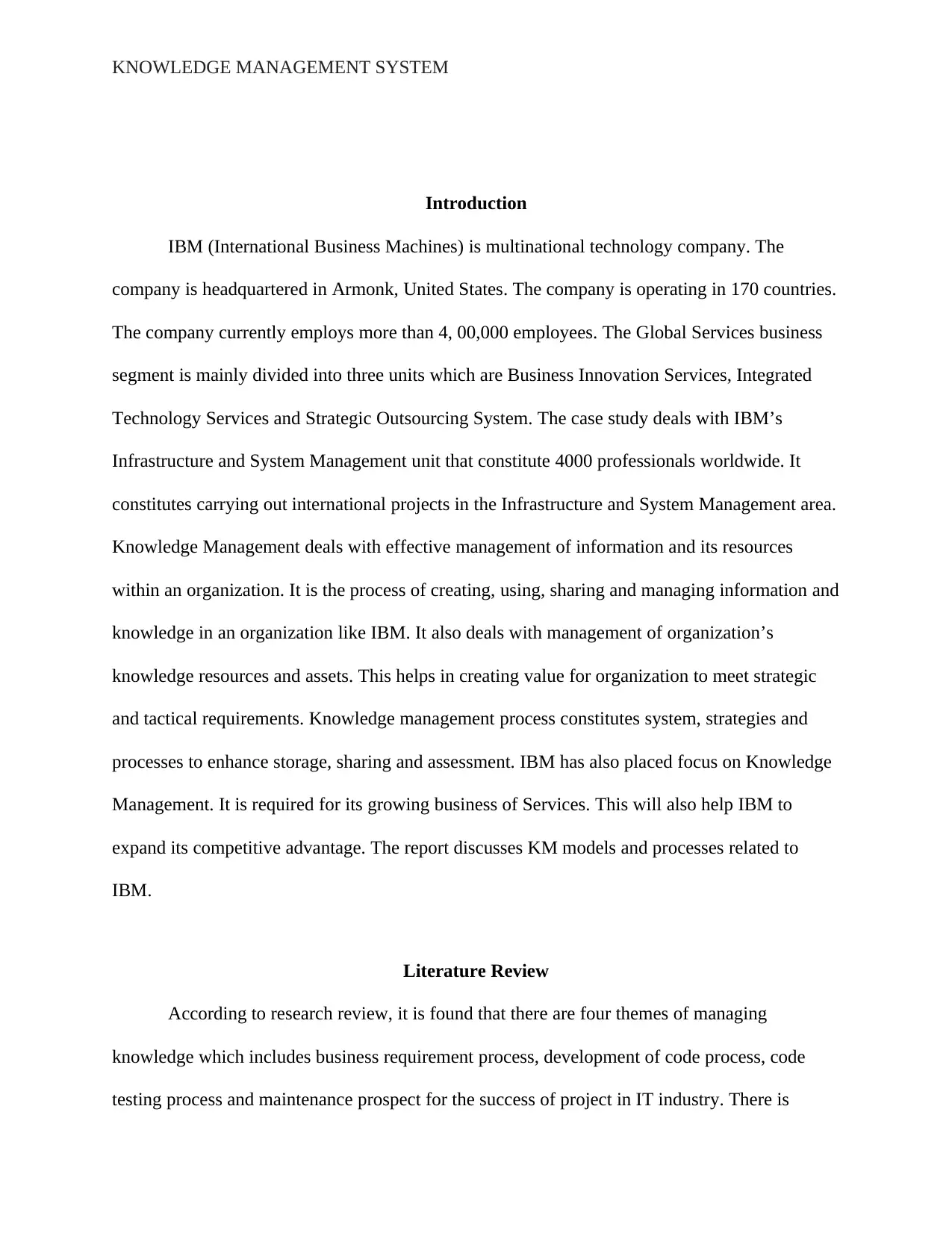
KNOWLEDGE MANAGEMENT SYSTEM
Introduction
IBM (International Business Machines) is multinational technology company. The
company is headquartered in Armonk, United States. The company is operating in 170 countries.
The company currently employs more than 4, 00,000 employees. The Global Services business
segment is mainly divided into three units which are Business Innovation Services, Integrated
Technology Services and Strategic Outsourcing System. The case study deals with IBM’s
Infrastructure and System Management unit that constitute 4000 professionals worldwide. It
constitutes carrying out international projects in the Infrastructure and System Management area.
Knowledge Management deals with effective management of information and its resources
within an organization. It is the process of creating, using, sharing and managing information and
knowledge in an organization like IBM. It also deals with management of organization’s
knowledge resources and assets. This helps in creating value for organization to meet strategic
and tactical requirements. Knowledge management process constitutes system, strategies and
processes to enhance storage, sharing and assessment. IBM has also placed focus on Knowledge
Management. It is required for its growing business of Services. This will also help IBM to
expand its competitive advantage. The report discusses KM models and processes related to
IBM.
Literature Review
According to research review, it is found that there are four themes of managing
knowledge which includes business requirement process, development of code process, code
testing process and maintenance prospect for the success of project in IT industry. There is
Introduction
IBM (International Business Machines) is multinational technology company. The
company is headquartered in Armonk, United States. The company is operating in 170 countries.
The company currently employs more than 4, 00,000 employees. The Global Services business
segment is mainly divided into three units which are Business Innovation Services, Integrated
Technology Services and Strategic Outsourcing System. The case study deals with IBM’s
Infrastructure and System Management unit that constitute 4000 professionals worldwide. It
constitutes carrying out international projects in the Infrastructure and System Management area.
Knowledge Management deals with effective management of information and its resources
within an organization. It is the process of creating, using, sharing and managing information and
knowledge in an organization like IBM. It also deals with management of organization’s
knowledge resources and assets. This helps in creating value for organization to meet strategic
and tactical requirements. Knowledge management process constitutes system, strategies and
processes to enhance storage, sharing and assessment. IBM has also placed focus on Knowledge
Management. It is required for its growing business of Services. This will also help IBM to
expand its competitive advantage. The report discusses KM models and processes related to
IBM.
Literature Review
According to research review, it is found that there are four themes of managing
knowledge which includes business requirement process, development of code process, code
testing process and maintenance prospect for the success of project in IT industry. There is
⊘ This is a preview!⊘
Do you want full access?
Subscribe today to unlock all pages.

Trusted by 1+ million students worldwide
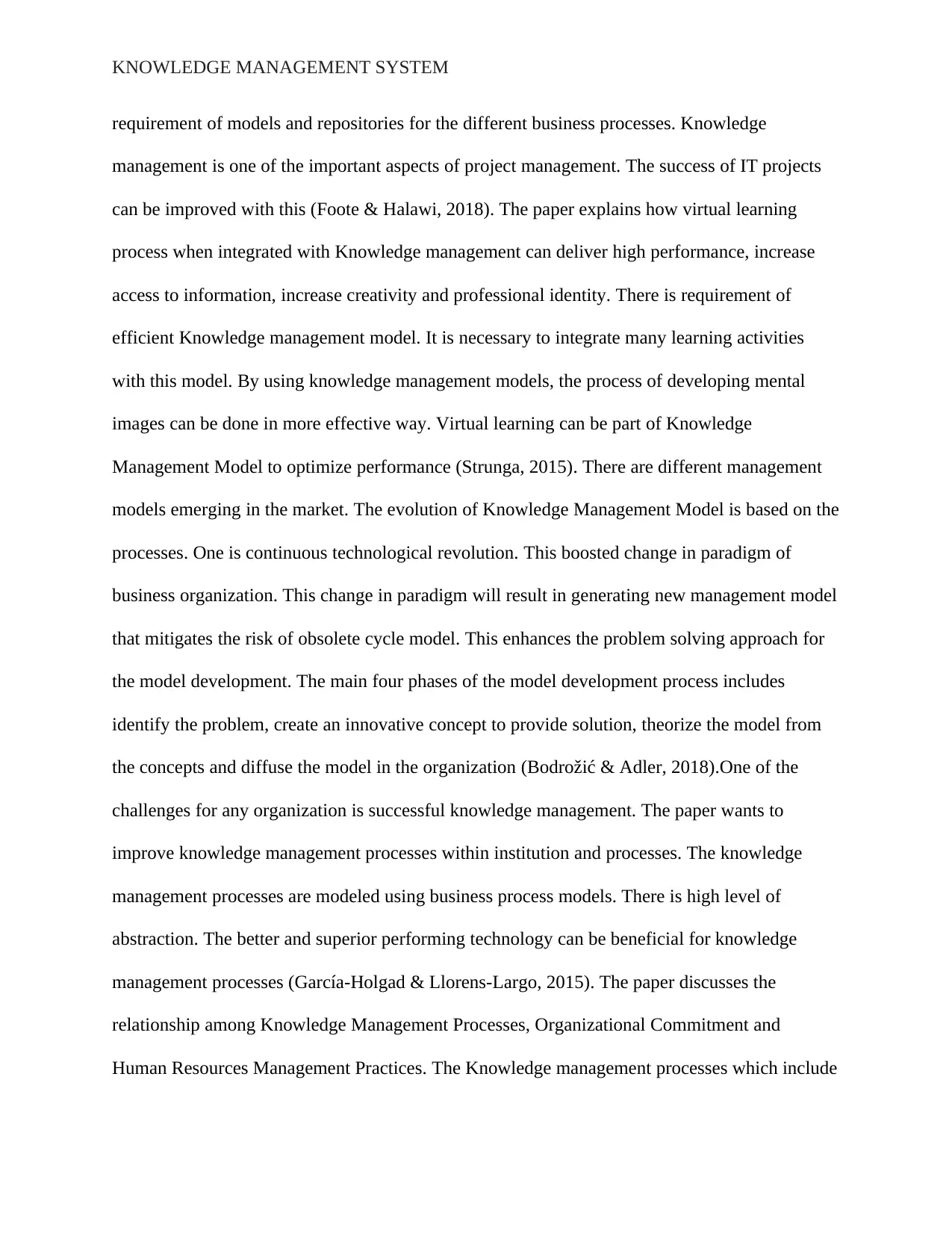
KNOWLEDGE MANAGEMENT SYSTEM
requirement of models and repositories for the different business processes. Knowledge
management is one of the important aspects of project management. The success of IT projects
can be improved with this (Foote & Halawi, 2018). The paper explains how virtual learning
process when integrated with Knowledge management can deliver high performance, increase
access to information, increase creativity and professional identity. There is requirement of
efficient Knowledge management model. It is necessary to integrate many learning activities
with this model. By using knowledge management models, the process of developing mental
images can be done in more effective way. Virtual learning can be part of Knowledge
Management Model to optimize performance (Strunga, 2015). There are different management
models emerging in the market. The evolution of Knowledge Management Model is based on the
processes. One is continuous technological revolution. This boosted change in paradigm of
business organization. This change in paradigm will result in generating new management model
that mitigates the risk of obsolete cycle model. This enhances the problem solving approach for
the model development. The main four phases of the model development process includes
identify the problem, create an innovative concept to provide solution, theorize the model from
the concepts and diffuse the model in the organization (Bodrožić & Adler, 2018).One of the
challenges for any organization is successful knowledge management. The paper wants to
improve knowledge management processes within institution and processes. The knowledge
management processes are modeled using business process models. There is high level of
abstraction. The better and superior performing technology can be beneficial for knowledge
management processes (García-Holgad & Llorens-Largo, 2015). The paper discusses the
relationship among Knowledge Management Processes, Organizational Commitment and
Human Resources Management Practices. The Knowledge management processes which include
requirement of models and repositories for the different business processes. Knowledge
management is one of the important aspects of project management. The success of IT projects
can be improved with this (Foote & Halawi, 2018). The paper explains how virtual learning
process when integrated with Knowledge management can deliver high performance, increase
access to information, increase creativity and professional identity. There is requirement of
efficient Knowledge management model. It is necessary to integrate many learning activities
with this model. By using knowledge management models, the process of developing mental
images can be done in more effective way. Virtual learning can be part of Knowledge
Management Model to optimize performance (Strunga, 2015). There are different management
models emerging in the market. The evolution of Knowledge Management Model is based on the
processes. One is continuous technological revolution. This boosted change in paradigm of
business organization. This change in paradigm will result in generating new management model
that mitigates the risk of obsolete cycle model. This enhances the problem solving approach for
the model development. The main four phases of the model development process includes
identify the problem, create an innovative concept to provide solution, theorize the model from
the concepts and diffuse the model in the organization (Bodrožić & Adler, 2018).One of the
challenges for any organization is successful knowledge management. The paper wants to
improve knowledge management processes within institution and processes. The knowledge
management processes are modeled using business process models. There is high level of
abstraction. The better and superior performing technology can be beneficial for knowledge
management processes (García-Holgad & Llorens-Largo, 2015). The paper discusses the
relationship among Knowledge Management Processes, Organizational Commitment and
Human Resources Management Practices. The Knowledge management processes which include
Paraphrase This Document
Need a fresh take? Get an instant paraphrase of this document with our AI Paraphraser

KNOWLEDGE MANAGEMENT SYSTEM
knowledge acquisition, distribution, interpretation and organizational memory do not have direct
relation with Human Resources Management Processes. There are causal link between
knowledge management processes and organizational commitment. Organizations should
consider human factor and increase human resources’ commitment to take benefit of their
knowledge (Alrubaiee & Al Ali, 2015).
Review of KMS
Information Management’s main focus is only on information whereas Knowledge
Management contributes to strategy that encourages generating, using, sharing and exploiting
knowledge (Ceptureanu, 2016). The two main components of Knowledge Management Solutions
constitute Knowledge Management System and Knowledge management processes. There are
three foundations on which Knowledge Management Solution depends. These are Knowledge
Management Technologies, Knowledge Management Mechanism and Knowledge Management
Infrastructure (Davenport, 2015). There are four types of Knowledge Processes. Each of these
processes comprises two sub-processes. The processes are Knowledge Discovery which consists
of Socialization and Combination, Knowledge Capture which includes Externalization and
Internalization, Knowledge Sharing which includes Socialization and Exchange, Knowledge
application which has directions and routines. Knowledge Management models are the
representation of Knowledge Management systems in an organization. The models like Nonaka
and Takeuchi deal with the transfer of tacit knowledge into explicit and vice versa. Tacit
Knowledge is the knowledge present in human mind through jobs and experience. This also
includes intuition and insights. However, explicit knowledge use digitized and codified
knowledge which is present in document, books, memos and report etc. (Geisler &
Wickramasinghe, 2015). The actions get facilitated by documented information. The Choo
knowledge acquisition, distribution, interpretation and organizational memory do not have direct
relation with Human Resources Management Processes. There are causal link between
knowledge management processes and organizational commitment. Organizations should
consider human factor and increase human resources’ commitment to take benefit of their
knowledge (Alrubaiee & Al Ali, 2015).
Review of KMS
Information Management’s main focus is only on information whereas Knowledge
Management contributes to strategy that encourages generating, using, sharing and exploiting
knowledge (Ceptureanu, 2016). The two main components of Knowledge Management Solutions
constitute Knowledge Management System and Knowledge management processes. There are
three foundations on which Knowledge Management Solution depends. These are Knowledge
Management Technologies, Knowledge Management Mechanism and Knowledge Management
Infrastructure (Davenport, 2015). There are four types of Knowledge Processes. Each of these
processes comprises two sub-processes. The processes are Knowledge Discovery which consists
of Socialization and Combination, Knowledge Capture which includes Externalization and
Internalization, Knowledge Sharing which includes Socialization and Exchange, Knowledge
application which has directions and routines. Knowledge Management models are the
representation of Knowledge Management systems in an organization. The models like Nonaka
and Takeuchi deal with the transfer of tacit knowledge into explicit and vice versa. Tacit
Knowledge is the knowledge present in human mind through jobs and experience. This also
includes intuition and insights. However, explicit knowledge use digitized and codified
knowledge which is present in document, books, memos and report etc. (Geisler &
Wickramasinghe, 2015). The actions get facilitated by documented information. The Choo
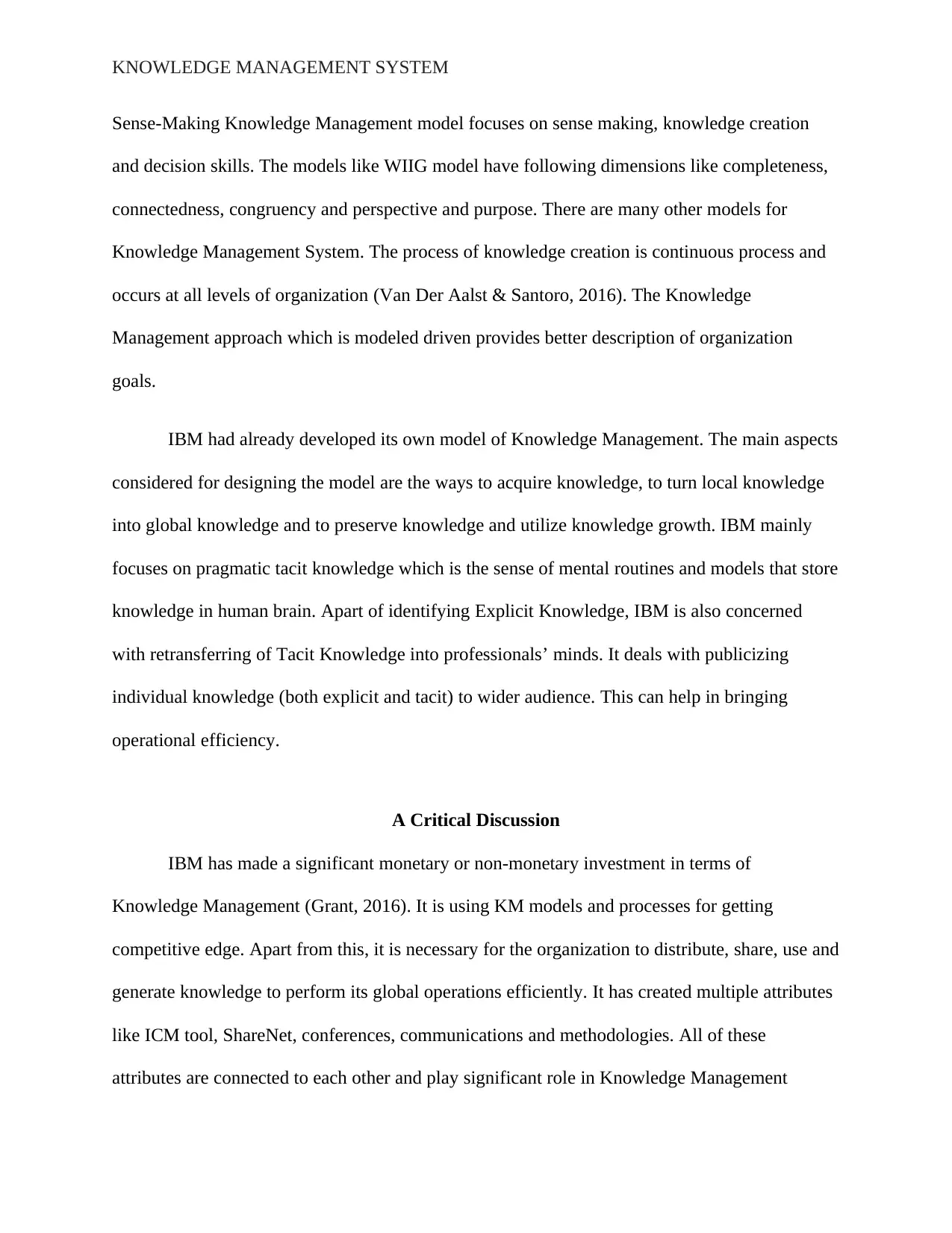
KNOWLEDGE MANAGEMENT SYSTEM
Sense-Making Knowledge Management model focuses on sense making, knowledge creation
and decision skills. The models like WIIG model have following dimensions like completeness,
connectedness, congruency and perspective and purpose. There are many other models for
Knowledge Management System. The process of knowledge creation is continuous process and
occurs at all levels of organization (Van Der Aalst & Santoro, 2016). The Knowledge
Management approach which is modeled driven provides better description of organization
goals.
IBM had already developed its own model of Knowledge Management. The main aspects
considered for designing the model are the ways to acquire knowledge, to turn local knowledge
into global knowledge and to preserve knowledge and utilize knowledge growth. IBM mainly
focuses on pragmatic tacit knowledge which is the sense of mental routines and models that store
knowledge in human brain. Apart of identifying Explicit Knowledge, IBM is also concerned
with retransferring of Tacit Knowledge into professionals’ minds. It deals with publicizing
individual knowledge (both explicit and tacit) to wider audience. This can help in bringing
operational efficiency.
A Critical Discussion
IBM has made a significant monetary or non-monetary investment in terms of
Knowledge Management (Grant, 2016). It is using KM models and processes for getting
competitive edge. Apart from this, it is necessary for the organization to distribute, share, use and
generate knowledge to perform its global operations efficiently. It has created multiple attributes
like ICM tool, ShareNet, conferences, communications and methodologies. All of these
attributes are connected to each other and play significant role in Knowledge Management
Sense-Making Knowledge Management model focuses on sense making, knowledge creation
and decision skills. The models like WIIG model have following dimensions like completeness,
connectedness, congruency and perspective and purpose. There are many other models for
Knowledge Management System. The process of knowledge creation is continuous process and
occurs at all levels of organization (Van Der Aalst & Santoro, 2016). The Knowledge
Management approach which is modeled driven provides better description of organization
goals.
IBM had already developed its own model of Knowledge Management. The main aspects
considered for designing the model are the ways to acquire knowledge, to turn local knowledge
into global knowledge and to preserve knowledge and utilize knowledge growth. IBM mainly
focuses on pragmatic tacit knowledge which is the sense of mental routines and models that store
knowledge in human brain. Apart of identifying Explicit Knowledge, IBM is also concerned
with retransferring of Tacit Knowledge into professionals’ minds. It deals with publicizing
individual knowledge (both explicit and tacit) to wider audience. This can help in bringing
operational efficiency.
A Critical Discussion
IBM has made a significant monetary or non-monetary investment in terms of
Knowledge Management (Grant, 2016). It is using KM models and processes for getting
competitive edge. Apart from this, it is necessary for the organization to distribute, share, use and
generate knowledge to perform its global operations efficiently. It has created multiple attributes
like ICM tool, ShareNet, conferences, communications and methodologies. All of these
attributes are connected to each other and play significant role in Knowledge Management
⊘ This is a preview!⊘
Do you want full access?
Subscribe today to unlock all pages.

Trusted by 1+ million students worldwide
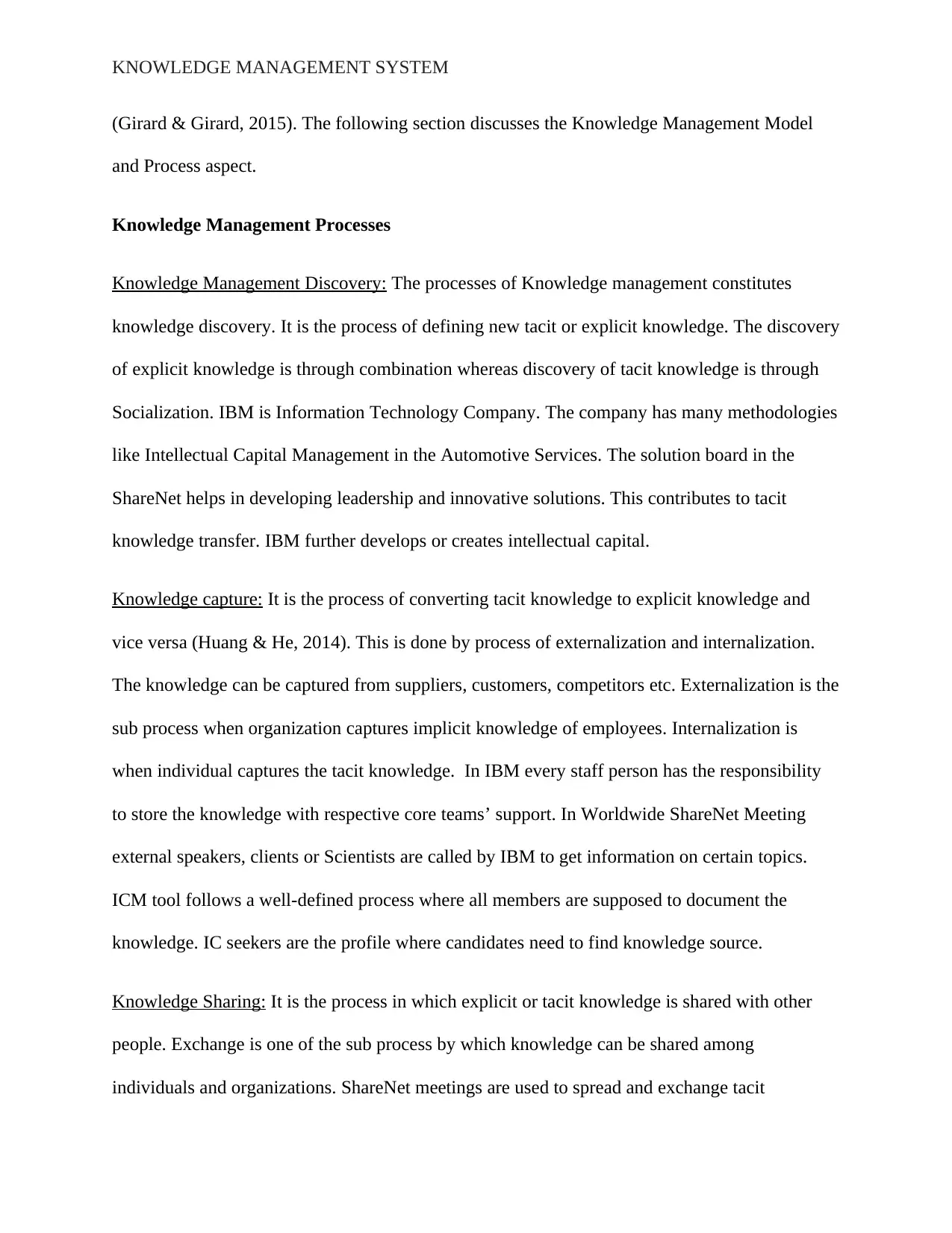
KNOWLEDGE MANAGEMENT SYSTEM
(Girard & Girard, 2015). The following section discusses the Knowledge Management Model
and Process aspect.
Knowledge Management Processes
Knowledge Management Discovery: The processes of Knowledge management constitutes
knowledge discovery. It is the process of defining new tacit or explicit knowledge. The discovery
of explicit knowledge is through combination whereas discovery of tacit knowledge is through
Socialization. IBM is Information Technology Company. The company has many methodologies
like Intellectual Capital Management in the Automotive Services. The solution board in the
ShareNet helps in developing leadership and innovative solutions. This contributes to tacit
knowledge transfer. IBM further develops or creates intellectual capital.
Knowledge capture: It is the process of converting tacit knowledge to explicit knowledge and
vice versa (Huang & He, 2014). This is done by process of externalization and internalization.
The knowledge can be captured from suppliers, customers, competitors etc. Externalization is the
sub process when organization captures implicit knowledge of employees. Internalization is
when individual captures the tacit knowledge. In IBM every staff person has the responsibility
to store the knowledge with respective core teams’ support. In Worldwide ShareNet Meeting
external speakers, clients or Scientists are called by IBM to get information on certain topics.
ICM tool follows a well-defined process where all members are supposed to document the
knowledge. IC seekers are the profile where candidates need to find knowledge source.
Knowledge Sharing: It is the process in which explicit or tacit knowledge is shared with other
people. Exchange is one of the sub process by which knowledge can be shared among
individuals and organizations. ShareNet meetings are used to spread and exchange tacit
(Girard & Girard, 2015). The following section discusses the Knowledge Management Model
and Process aspect.
Knowledge Management Processes
Knowledge Management Discovery: The processes of Knowledge management constitutes
knowledge discovery. It is the process of defining new tacit or explicit knowledge. The discovery
of explicit knowledge is through combination whereas discovery of tacit knowledge is through
Socialization. IBM is Information Technology Company. The company has many methodologies
like Intellectual Capital Management in the Automotive Services. The solution board in the
ShareNet helps in developing leadership and innovative solutions. This contributes to tacit
knowledge transfer. IBM further develops or creates intellectual capital.
Knowledge capture: It is the process of converting tacit knowledge to explicit knowledge and
vice versa (Huang & He, 2014). This is done by process of externalization and internalization.
The knowledge can be captured from suppliers, customers, competitors etc. Externalization is the
sub process when organization captures implicit knowledge of employees. Internalization is
when individual captures the tacit knowledge. In IBM every staff person has the responsibility
to store the knowledge with respective core teams’ support. In Worldwide ShareNet Meeting
external speakers, clients or Scientists are called by IBM to get information on certain topics.
ICM tool follows a well-defined process where all members are supposed to document the
knowledge. IC seekers are the profile where candidates need to find knowledge source.
Knowledge Sharing: It is the process in which explicit or tacit knowledge is shared with other
people. Exchange is one of the sub process by which knowledge can be shared among
individuals and organizations. ShareNet meetings are used to spread and exchange tacit
Paraphrase This Document
Need a fresh take? Get an instant paraphrase of this document with our AI Paraphraser
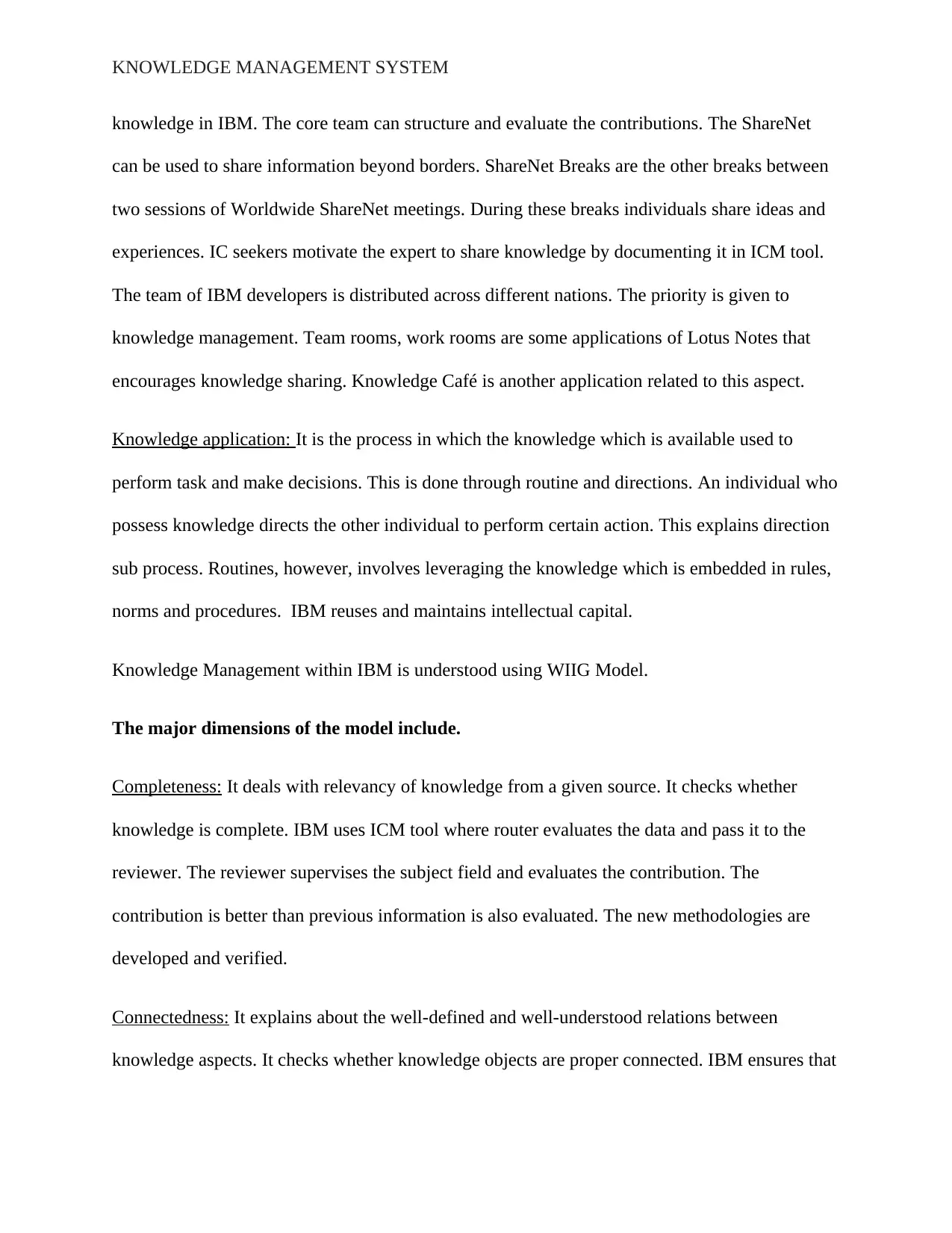
KNOWLEDGE MANAGEMENT SYSTEM
knowledge in IBM. The core team can structure and evaluate the contributions. The ShareNet
can be used to share information beyond borders. ShareNet Breaks are the other breaks between
two sessions of Worldwide ShareNet meetings. During these breaks individuals share ideas and
experiences. IC seekers motivate the expert to share knowledge by documenting it in ICM tool.
The team of IBM developers is distributed across different nations. The priority is given to
knowledge management. Team rooms, work rooms are some applications of Lotus Notes that
encourages knowledge sharing. Knowledge Café is another application related to this aspect.
Knowledge application: It is the process in which the knowledge which is available used to
perform task and make decisions. This is done through routine and directions. An individual who
possess knowledge directs the other individual to perform certain action. This explains direction
sub process. Routines, however, involves leveraging the knowledge which is embedded in rules,
norms and procedures. IBM reuses and maintains intellectual capital.
Knowledge Management within IBM is understood using WIIG Model.
The major dimensions of the model include.
Completeness: It deals with relevancy of knowledge from a given source. It checks whether
knowledge is complete. IBM uses ICM tool where router evaluates the data and pass it to the
reviewer. The reviewer supervises the subject field and evaluates the contribution. The
contribution is better than previous information is also evaluated. The new methodologies are
developed and verified.
Connectedness: It explains about the well-defined and well-understood relations between
knowledge aspects. It checks whether knowledge objects are proper connected. IBM ensures that
knowledge in IBM. The core team can structure and evaluate the contributions. The ShareNet
can be used to share information beyond borders. ShareNet Breaks are the other breaks between
two sessions of Worldwide ShareNet meetings. During these breaks individuals share ideas and
experiences. IC seekers motivate the expert to share knowledge by documenting it in ICM tool.
The team of IBM developers is distributed across different nations. The priority is given to
knowledge management. Team rooms, work rooms are some applications of Lotus Notes that
encourages knowledge sharing. Knowledge Café is another application related to this aspect.
Knowledge application: It is the process in which the knowledge which is available used to
perform task and make decisions. This is done through routine and directions. An individual who
possess knowledge directs the other individual to perform certain action. This explains direction
sub process. Routines, however, involves leveraging the knowledge which is embedded in rules,
norms and procedures. IBM reuses and maintains intellectual capital.
Knowledge Management within IBM is understood using WIIG Model.
The major dimensions of the model include.
Completeness: It deals with relevancy of knowledge from a given source. It checks whether
knowledge is complete. IBM uses ICM tool where router evaluates the data and pass it to the
reviewer. The reviewer supervises the subject field and evaluates the contribution. The
contribution is better than previous information is also evaluated. The new methodologies are
developed and verified.
Connectedness: It explains about the well-defined and well-understood relations between
knowledge aspects. It checks whether knowledge objects are proper connected. IBM ensures that
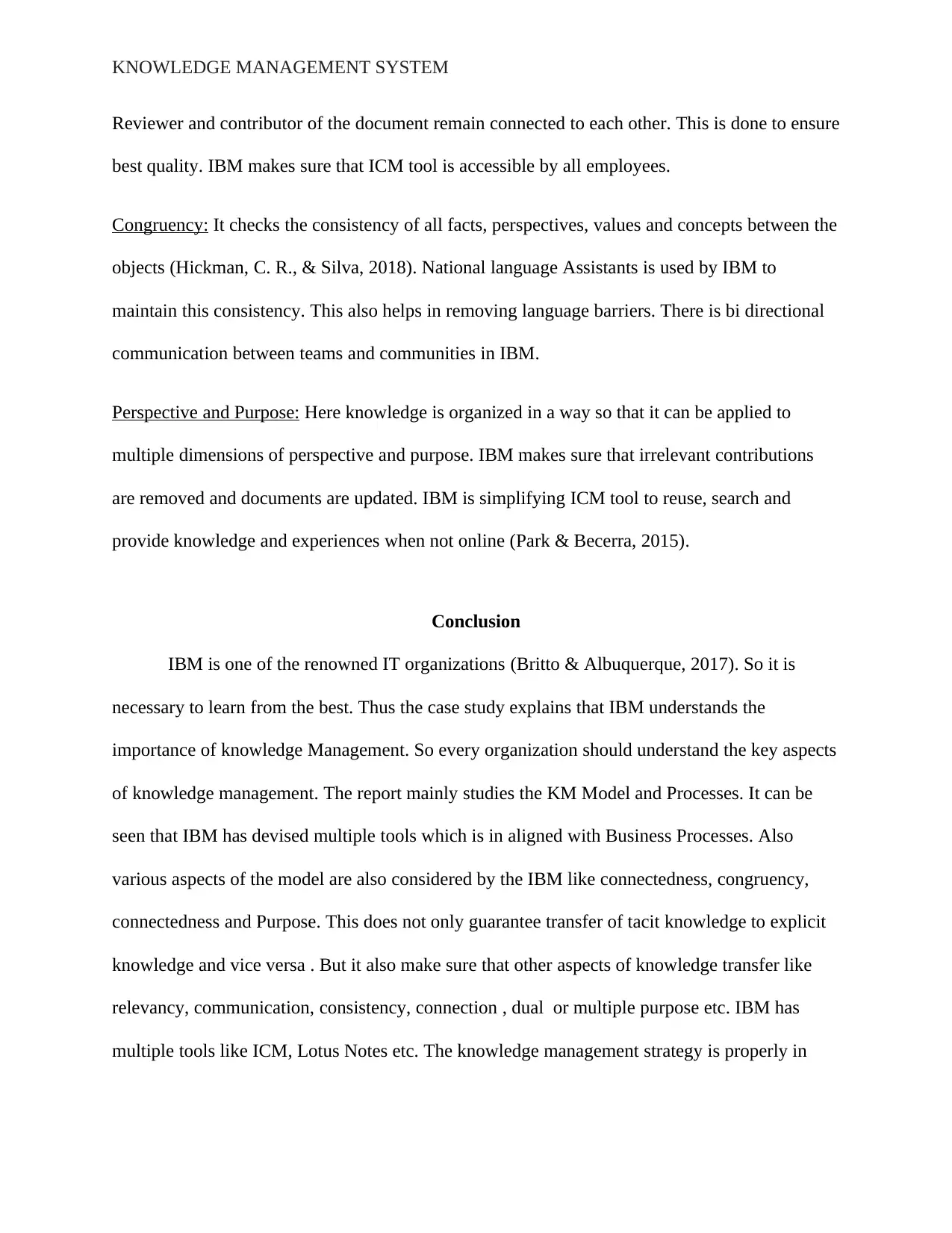
KNOWLEDGE MANAGEMENT SYSTEM
Reviewer and contributor of the document remain connected to each other. This is done to ensure
best quality. IBM makes sure that ICM tool is accessible by all employees.
Congruency: It checks the consistency of all facts, perspectives, values and concepts between the
objects (Hickman, C. R., & Silva, 2018). National language Assistants is used by IBM to
maintain this consistency. This also helps in removing language barriers. There is bi directional
communication between teams and communities in IBM.
Perspective and Purpose: Here knowledge is organized in a way so that it can be applied to
multiple dimensions of perspective and purpose. IBM makes sure that irrelevant contributions
are removed and documents are updated. IBM is simplifying ICM tool to reuse, search and
provide knowledge and experiences when not online (Park & Becerra, 2015).
Conclusion
IBM is one of the renowned IT organizations (Britto & Albuquerque, 2017). So it is
necessary to learn from the best. Thus the case study explains that IBM understands the
importance of knowledge Management. So every organization should understand the key aspects
of knowledge management. The report mainly studies the KM Model and Processes. It can be
seen that IBM has devised multiple tools which is in aligned with Business Processes. Also
various aspects of the model are also considered by the IBM like connectedness, congruency,
connectedness and Purpose. This does not only guarantee transfer of tacit knowledge to explicit
knowledge and vice versa . But it also make sure that other aspects of knowledge transfer like
relevancy, communication, consistency, connection , dual or multiple purpose etc. IBM has
multiple tools like ICM, Lotus Notes etc. The knowledge management strategy is properly in
Reviewer and contributor of the document remain connected to each other. This is done to ensure
best quality. IBM makes sure that ICM tool is accessible by all employees.
Congruency: It checks the consistency of all facts, perspectives, values and concepts between the
objects (Hickman, C. R., & Silva, 2018). National language Assistants is used by IBM to
maintain this consistency. This also helps in removing language barriers. There is bi directional
communication between teams and communities in IBM.
Perspective and Purpose: Here knowledge is organized in a way so that it can be applied to
multiple dimensions of perspective and purpose. IBM makes sure that irrelevant contributions
are removed and documents are updated. IBM is simplifying ICM tool to reuse, search and
provide knowledge and experiences when not online (Park & Becerra, 2015).
Conclusion
IBM is one of the renowned IT organizations (Britto & Albuquerque, 2017). So it is
necessary to learn from the best. Thus the case study explains that IBM understands the
importance of knowledge Management. So every organization should understand the key aspects
of knowledge management. The report mainly studies the KM Model and Processes. It can be
seen that IBM has devised multiple tools which is in aligned with Business Processes. Also
various aspects of the model are also considered by the IBM like connectedness, congruency,
connectedness and Purpose. This does not only guarantee transfer of tacit knowledge to explicit
knowledge and vice versa . But it also make sure that other aspects of knowledge transfer like
relevancy, communication, consistency, connection , dual or multiple purpose etc. IBM has
multiple tools like ICM, Lotus Notes etc. The knowledge management strategy is properly in
⊘ This is a preview!⊘
Do you want full access?
Subscribe today to unlock all pages.

Trusted by 1+ million students worldwide

KNOWLEDGE MANAGEMENT SYSTEM
place for future. The company has considered all the aspects in order to bring best experience to
its clients and customers.
place for future. The company has considered all the aspects in order to bring best experience to
its clients and customers.
Paraphrase This Document
Need a fresh take? Get an instant paraphrase of this document with our AI Paraphraser
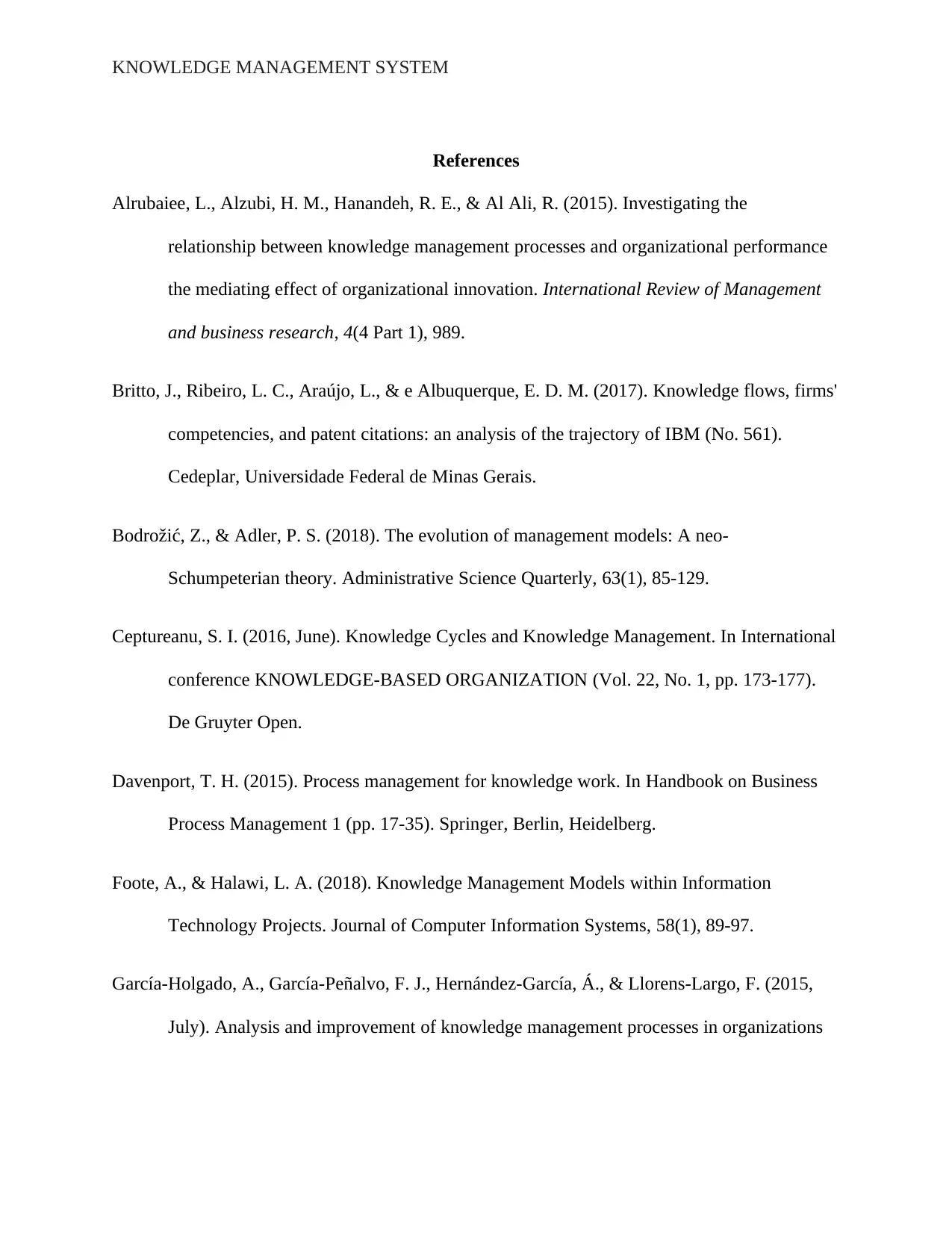
KNOWLEDGE MANAGEMENT SYSTEM
References
Alrubaiee, L., Alzubi, H. M., Hanandeh, R. E., & Al Ali, R. (2015). Investigating the
relationship between knowledge management processes and organizational performance
the mediating effect of organizational innovation. International Review of Management
and business research, 4(4 Part 1), 989.
Britto, J., Ribeiro, L. C., Araújo, L., & e Albuquerque, E. D. M. (2017). Knowledge flows, firms'
competencies, and patent citations: an analysis of the trajectory of IBM (No. 561).
Cedeplar, Universidade Federal de Minas Gerais.
Bodrožić, Z., & Adler, P. S. (2018). The evolution of management models: A neo-
Schumpeterian theory. Administrative Science Quarterly, 63(1), 85-129.
Ceptureanu, S. I. (2016, June). Knowledge Cycles and Knowledge Management. In International
conference KNOWLEDGE-BASED ORGANIZATION (Vol. 22, No. 1, pp. 173-177).
De Gruyter Open.
Davenport, T. H. (2015). Process management for knowledge work. In Handbook on Business
Process Management 1 (pp. 17-35). Springer, Berlin, Heidelberg.
Foote, A., & Halawi, L. A. (2018). Knowledge Management Models within Information
Technology Projects. Journal of Computer Information Systems, 58(1), 89-97.
García-Holgado, A., García-Peñalvo, F. J., Hernández-García, Á., & Llorens-Largo, F. (2015,
July). Analysis and improvement of knowledge management processes in organizations
References
Alrubaiee, L., Alzubi, H. M., Hanandeh, R. E., & Al Ali, R. (2015). Investigating the
relationship between knowledge management processes and organizational performance
the mediating effect of organizational innovation. International Review of Management
and business research, 4(4 Part 1), 989.
Britto, J., Ribeiro, L. C., Araújo, L., & e Albuquerque, E. D. M. (2017). Knowledge flows, firms'
competencies, and patent citations: an analysis of the trajectory of IBM (No. 561).
Cedeplar, Universidade Federal de Minas Gerais.
Bodrožić, Z., & Adler, P. S. (2018). The evolution of management models: A neo-
Schumpeterian theory. Administrative Science Quarterly, 63(1), 85-129.
Ceptureanu, S. I. (2016, June). Knowledge Cycles and Knowledge Management. In International
conference KNOWLEDGE-BASED ORGANIZATION (Vol. 22, No. 1, pp. 173-177).
De Gruyter Open.
Davenport, T. H. (2015). Process management for knowledge work. In Handbook on Business
Process Management 1 (pp. 17-35). Springer, Berlin, Heidelberg.
Foote, A., & Halawi, L. A. (2018). Knowledge Management Models within Information
Technology Projects. Journal of Computer Information Systems, 58(1), 89-97.
García-Holgado, A., García-Peñalvo, F. J., Hernández-García, Á., & Llorens-Largo, F. (2015,
July). Analysis and improvement of knowledge management processes in organizations
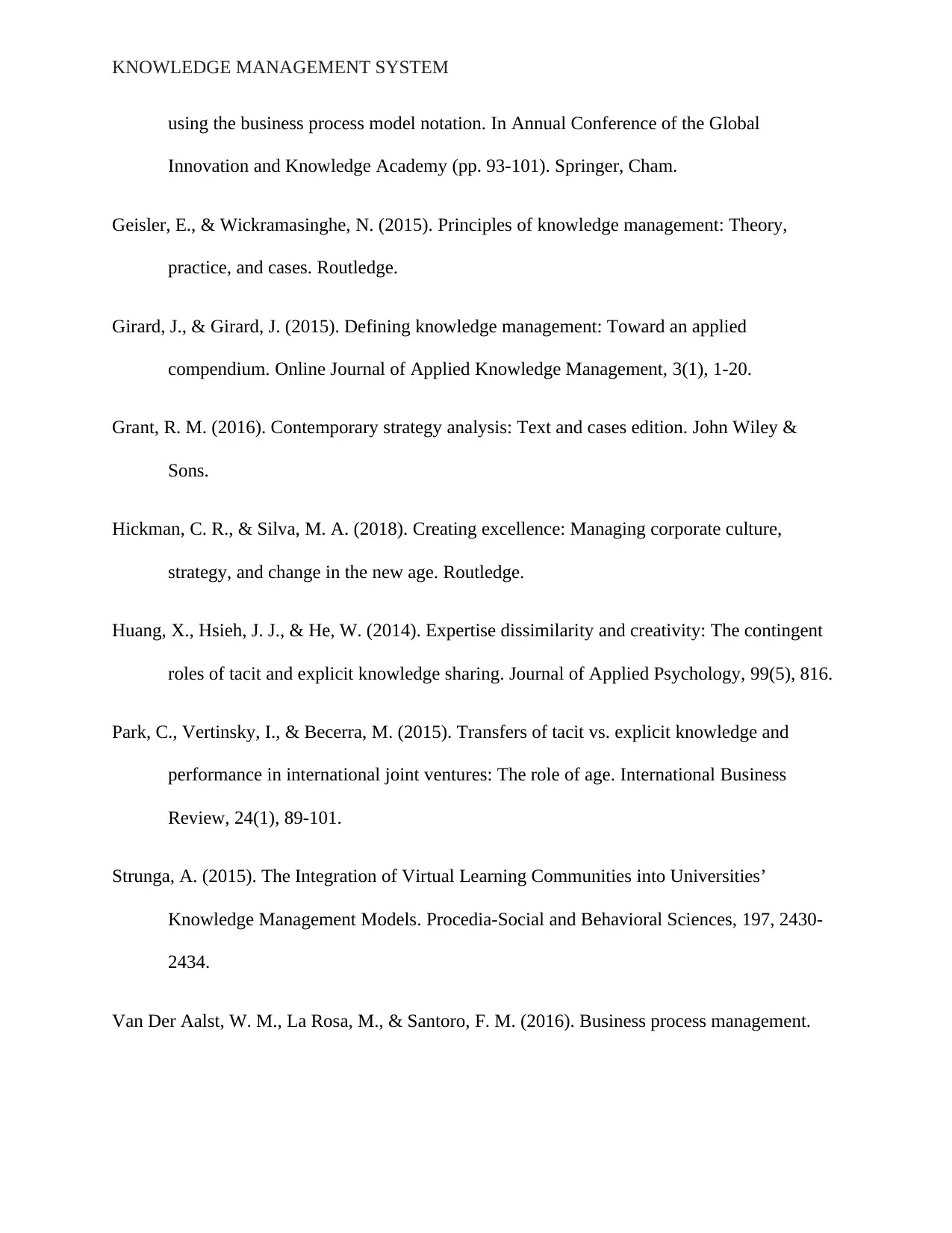
KNOWLEDGE MANAGEMENT SYSTEM
using the business process model notation. In Annual Conference of the Global
Innovation and Knowledge Academy (pp. 93-101). Springer, Cham.
Geisler, E., & Wickramasinghe, N. (2015). Principles of knowledge management: Theory,
practice, and cases. Routledge.
Girard, J., & Girard, J. (2015). Defining knowledge management: Toward an applied
compendium. Online Journal of Applied Knowledge Management, 3(1), 1-20.
Grant, R. M. (2016). Contemporary strategy analysis: Text and cases edition. John Wiley &
Sons.
Hickman, C. R., & Silva, M. A. (2018). Creating excellence: Managing corporate culture,
strategy, and change in the new age. Routledge.
Huang, X., Hsieh, J. J., & He, W. (2014). Expertise dissimilarity and creativity: The contingent
roles of tacit and explicit knowledge sharing. Journal of Applied Psychology, 99(5), 816.
Park, C., Vertinsky, I., & Becerra, M. (2015). Transfers of tacit vs. explicit knowledge and
performance in international joint ventures: The role of age. International Business
Review, 24(1), 89-101.
Strunga, A. (2015). The Integration of Virtual Learning Communities into Universities’
Knowledge Management Models. Procedia-Social and Behavioral Sciences, 197, 2430-
2434.
Van Der Aalst, W. M., La Rosa, M., & Santoro, F. M. (2016). Business process management.
using the business process model notation. In Annual Conference of the Global
Innovation and Knowledge Academy (pp. 93-101). Springer, Cham.
Geisler, E., & Wickramasinghe, N. (2015). Principles of knowledge management: Theory,
practice, and cases. Routledge.
Girard, J., & Girard, J. (2015). Defining knowledge management: Toward an applied
compendium. Online Journal of Applied Knowledge Management, 3(1), 1-20.
Grant, R. M. (2016). Contemporary strategy analysis: Text and cases edition. John Wiley &
Sons.
Hickman, C. R., & Silva, M. A. (2018). Creating excellence: Managing corporate culture,
strategy, and change in the new age. Routledge.
Huang, X., Hsieh, J. J., & He, W. (2014). Expertise dissimilarity and creativity: The contingent
roles of tacit and explicit knowledge sharing. Journal of Applied Psychology, 99(5), 816.
Park, C., Vertinsky, I., & Becerra, M. (2015). Transfers of tacit vs. explicit knowledge and
performance in international joint ventures: The role of age. International Business
Review, 24(1), 89-101.
Strunga, A. (2015). The Integration of Virtual Learning Communities into Universities’
Knowledge Management Models. Procedia-Social and Behavioral Sciences, 197, 2430-
2434.
Van Der Aalst, W. M., La Rosa, M., & Santoro, F. M. (2016). Business process management.
⊘ This is a preview!⊘
Do you want full access?
Subscribe today to unlock all pages.

Trusted by 1+ million students worldwide
1 out of 12
Related Documents
Your All-in-One AI-Powered Toolkit for Academic Success.
+13062052269
info@desklib.com
Available 24*7 on WhatsApp / Email
![[object Object]](/_next/static/media/star-bottom.7253800d.svg)
Unlock your academic potential
Copyright © 2020–2025 A2Z Services. All Rights Reserved. Developed and managed by ZUCOL.




